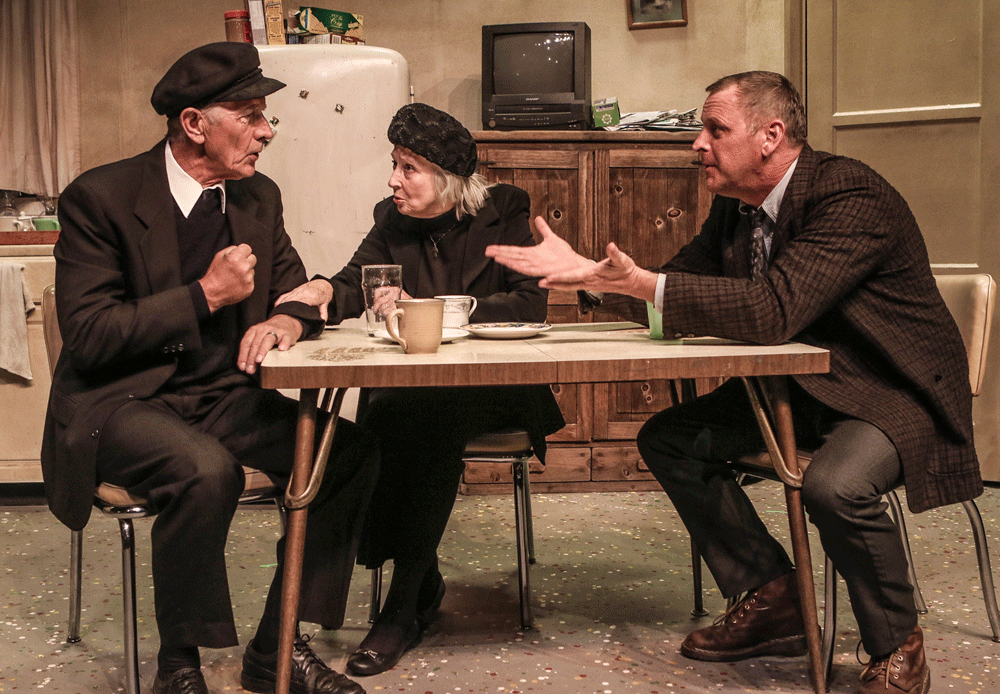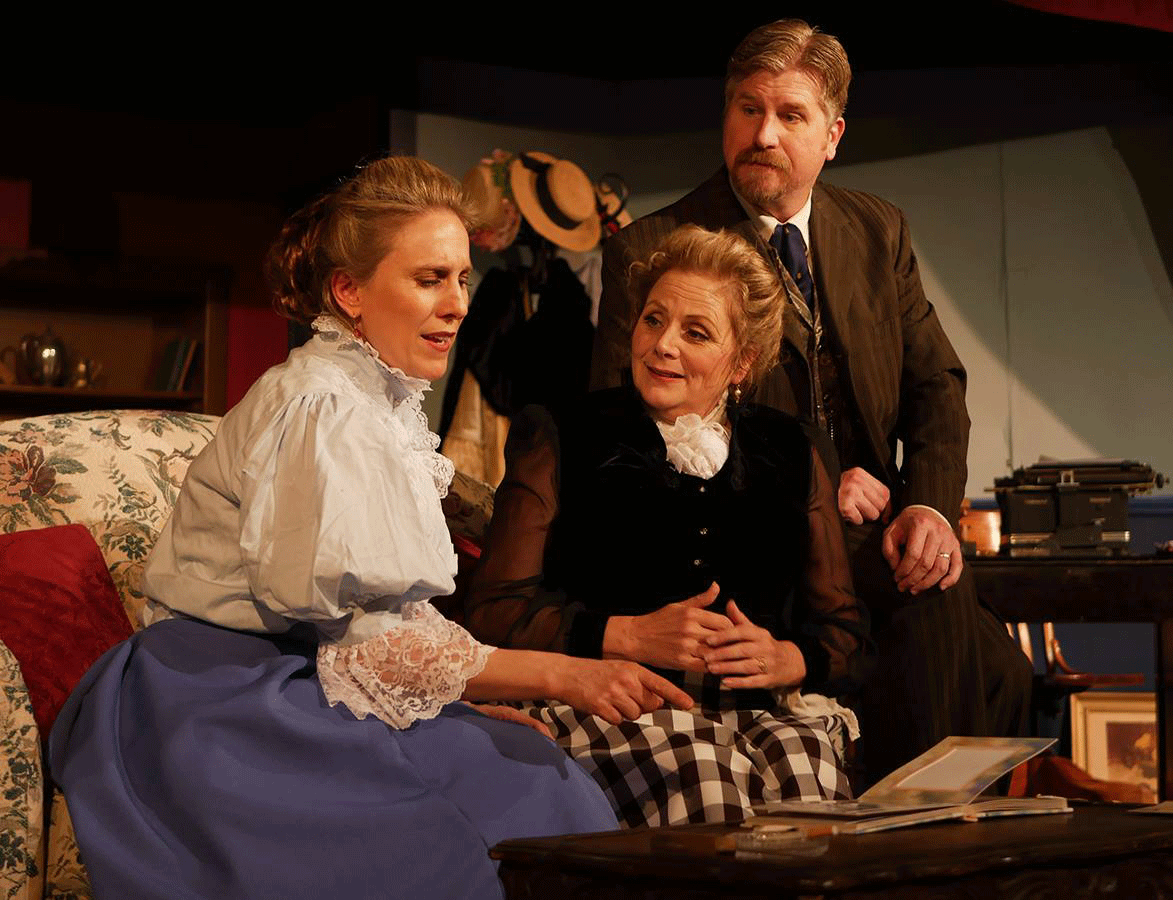Theatre
Review
Santa Paula Theatre Center’s Outside Mullingar and The Elite Theatre Company’s Engaging Shaw
Though profoundly different in virtually every other aspect, the current offering of two 805 theatres, the Santa Paula Theatre Center’s Outside Mullingar and the Elite Theatre’s Engaging Shaw, feature the exact same theme: the long-term wooings of a woman for a remarkably resistant man.
John Patrick Shanley’s Outside Mullingar builds steadily to a rapture driven by the poetry of Shanley’s language and Jessi May Stevenson’s alluringly translucent acting, while John Morogiello’s Engaging Shaw offers quite different fare.
While I applaud the Elite’s courage in choosing to do Engagning Shaw--even more so in choosing a dynamic dramatic lineup for their entire season that is more than worth getting season tickets for, and more than deserving of our support---it is a tricky play to do for a community theatre. It has so many potential pitfalls; there are so many plays that are far easier for a community theatre to pull off successfully.
Santa Paula’s Mullingar, on the other hand, is the kind of play that is well suited to community theatre. Stripped down to a beautifully told tale of love long-sought and slowly won, with straightforward, non-complicating sets, it contains only four parts and therefore gives a community theatre the possibility of reaching professional-level acting, which is what SPTC does.

Cecil Sutton (left) as Tony, Rosalee Calvillo as Aoife, and Ron Feltner as Anthony in the romantic Irish comedy
OUTSIDE MULLINGAR by John Patrick Shanley playing through May 28 at the Santa Paula Theater Center
Photo Credit: Brian Stethem
Though treating the same theme and covering very similar psychological terrain, the plays could hardly be more different. The man to be wooed in the Elite’s Engaging Shaw, is George Bernard Shaw, one of the most brilliant and wittiest men of letters of all time. The man to be wooed in SPTC’s Outside Mullingar is the slow, a bit odd, and somewhat brutish but kindly, son of an impoverished Irish farmer with “nary a hair of wit in him”.
Nor could the women doing the wooing be more different as well: The woman after Shaw is the notorious Charlotte Payne Townsend, herself a legend in her own time, the wealthy proponent of women’s suffrage and benefactor of London’s famous Fabian Socialists, who championed a peculiar non-Marxist brand of economic socialism while also supporting equal rights and education for women combined with the sexual free-thinking of the Bloomsbury literatii, many of whom were also Fabian Socialists. Rosemary, the woman after the man in Mulllingar, is an enigmatic match for any man, as well as a sly concoction of a playwright wanting to say something underneath the surface of his simply wrought tale. While the fabians in Shaw bluster and shout about strong women equal to any men, yet in the end insist that their women defer to their men; Mullingar’s Rosemary is a strong woman equal to any man, and remains delightfully so to the very end.
Nor could the playwrights, John Patrick Shanley and John Morogiello be more different. Shanley’s Mullingar is a beautifully written Irish tale, sweet romantic blarney impeccably constructed for the stage and ease of production. It’s a simple, straightforward tale, told with great empathy and good-humour. Morogiello’s play is loaded with witty long liftings directly out of George Bernard Shaw, a Post-Modern mish-mash featuring four real-life characters recognizable to the educated London at the turn of the last century.
In SPTC’s Mullingar, Cecil Sutton delivers fantastically on what is becoming a specialty: the conniving and dying old father who torments his odd and outcast son, played by Ron Fletner, the man to be wooed. Rosale Calvillo provides a wonderfully sympathetic Aoife, the mother of Rosemary, while the star who steals the show, Jessi May Stevenson, gives us a heart-breakingly fey, and thus appropriately Irish, reading of Rosemary.
Fey is an old, an odd, gallic concept meaning a state of peculiar and uncanny awareness or consciousness rarely reached, transcending the little-minded difficulties of everyday life and the vileness of people, where one enters a state of mind or grace more aware of fate and the more impenetrable things of life, usually achieved only by someone when touched deeply by death or the underbelly of love: both prerequisites being part of Rosemary’s situation.
In fact, on one level, a deeper level, Shanley’s Rosemary could be read as an intriguing sub-text rumination on fey and fey-ness. The great beauty and power of this SPTC production is that Jessi May Stevenson seems to have tapped into some deeply intuitive understanding of this.
We get the first glimpse of Rosemary’s feyness when Stevenson has her sniffing gently the aroma of her late father’s pipe in a scene in a woodshed in the rain marvelously rendered by Stevenson and Feltner. By the end of the scene Stevenson has us, heart and soul, and does not let go till we’ve seen the end of the play.

Engaging Shaw playing through May 21 at the Elite Theatre Company
Photo Credit: Joe Orrego
Photo Credit: Joe Orrego
The fey is like Irish magic and it pervades and saves this play, keeping it from a more superficial reading. Audiences sense this and come out of this play feeling its special charm and warmth. Fey is what Joyce shows in Finnegan’s Wake as one of the reasons the Irish celebrate wakes, while the rest of us suffer funerals. It’s the craziness behind the birds and bees and flowers of Shanley’s deceptive little enchantment. It’s no whim of the playwright that key scenes occur after deaths. David Ralphe’s direction doesn’t hurt either.
While Shanley’s language flows and entrances, Morogiello prefers to beat his theme to death. In spite of the flaws of a play that could have handled its material in half the time and much better, the Elite’s cast and crew do some interesting things with it. The cast is four real-life characters: George Bernard Shaw, the great Irish playwright, his eventual wife of nearly four decades, fabulously wealthy free-thinker Charlotte Payne Townsend, and Sidney and Beatrice Webb leaders of London’s Fabian Socialist Society. The Webb’s most lasting influence was in their role in the creation of the London School of Economics, still a powerhouse in modern economics today and in both real life and this play, they ruthlessly used both Shaw and Townsend to further their aims.
Morogiello’s play is a completely different beast than Shanley’s: built out of a pastische of Shaw’s own writing, it starts out hovering somewhere between a period costume drama, a witty sit-com, and a classic farce. Halfway through the first half, Morogiello collapses the complexities of parlour intrigue into a single dramatic thread worth about ten minutes of our attention that will instead be stretched out for the remaining three-quarters of the play. To make things worse, in the second half Morogiello shifts to an entirely different, far more abstract concoction based on the written correspondence between all four characters, then ends in a pseudo-Bergmannesque confrontation between the two protagonists; in all milking the lone dramatic arc for far more than its worth. The second half of the script is a mess, full of odd flaws and potential problems for stage production. There’s a great play in there somewhere, but it would take a radical Morogiello rewrite and discarding at least 30 minutes of material to find it. It would help if Morogiello remembered at all times that he was writing for stage, not television; all too often he creates sequences that are problematic for staging that would be trivial to shoot.
To the Elite’s credit, what good there is to find, they manage to find it. Lee Ann Ivy is particularly good as Beatrice Webb, while Paul Suzman gives us a delightful Sidney Webb. Anna Kotula gives us a Charlotte Townsend who is at her best when she is on her game, and appropriately insufferable when she suffers, while Buddy Wilds gives a wonderfully engaging Shaw. Wilds’ and Ivy’s work alone are worth seeing, and the entire cast is a strong ensemble, damn the script.
Both plays end with a tete-a-tete confrontation between the two potential lovers and at times cover exactly the same dramatic terrain, with lines written by witty Irishmen of two significantly different eras, written and lifted by two significantly different playwrights, in the end saying two significantly different things.
___________________________________
Outside Mullingar by John Patrick Stanley
Directed by David Ralphe
Starring Cecil Sutton, Jessi May Stevenson, Ron Feltner, Rosalee Calvillo
Produced by Leslie Nichols, Mike Carnahan sets, Gary Richardson lighting, David Ralphe sound design, Barbara Pedziwiatr costumes, Gail Heck props, and Colette Swan Stage Manager.
Directed by David Ralphe
Starring Cecil Sutton, Jessi May Stevenson, Ron Feltner, Rosalee Calvillo
Produced by Leslie Nichols, Mike Carnahan sets, Gary Richardson lighting, David Ralphe sound design, Barbara Pedziwiatr costumes, Gail Heck props, and Colette Swan Stage Manager.
Santa Paula Theatre Center
125 South Seventh Street, Santa Paula, California
For tickets, reservations, show times and information:
805.525.4645 | www.santapaulatheatrecenter.org
Engaging Shaw by John Morogiello
Directed by Steve Grumette [and lighting and sound design]
Starring Lee Ann Ivy, Buddy Wilds, Paul Sulzman, Anna Kotula
Tom Eubanks, Artistic Director
Produced by Ezra Eells, with Stephanie Rice Managing Producer; Christina Colombo Stage Manager, Set Designer and Designer, and Prop Mistress; Pat Lawler Technical Director; Ezra Ells and Trent Trachtenberg Stage Crew; Sheryl Jo Bedal Costume Designer and Set Decorator, Steve Mitchell, Set Constructor.
Directed by Steve Grumette [and lighting and sound design]
Starring Lee Ann Ivy, Buddy Wilds, Paul Sulzman, Anna Kotula
Tom Eubanks, Artistic Director
Produced by Ezra Eells, with Stephanie Rice Managing Producer; Christina Colombo Stage Manager, Set Designer and Designer, and Prop Mistress; Pat Lawler Technical Director; Ezra Ells and Trent Trachtenberg Stage Crew; Sheryl Jo Bedal Costume Designer and Set Decorator, Steve Mitchell, Set Constructor.
Through 28 May 2017
Elite Theatre Company
2731 South Victoria Avenue
Oxnard, Califonria
Channel Islands Harbor, Oxnard
Tickets: 805.483.5118, www.elitetheatre.org
Fridays and Saturdays 8 pm
Saturdays 2 pm
Also featuring South Stage Theatre for innovative and new works.
2731 South Victoria Avenue
Oxnard, Califonria
Channel Islands Harbor, Oxnard
Tickets: 805.483.5118, www.elitetheatre.org
Fridays and Saturdays 8 pm
Saturdays 2 pm
Also featuring South Stage Theatre for innovative and new works.
Through 21 May 2017

